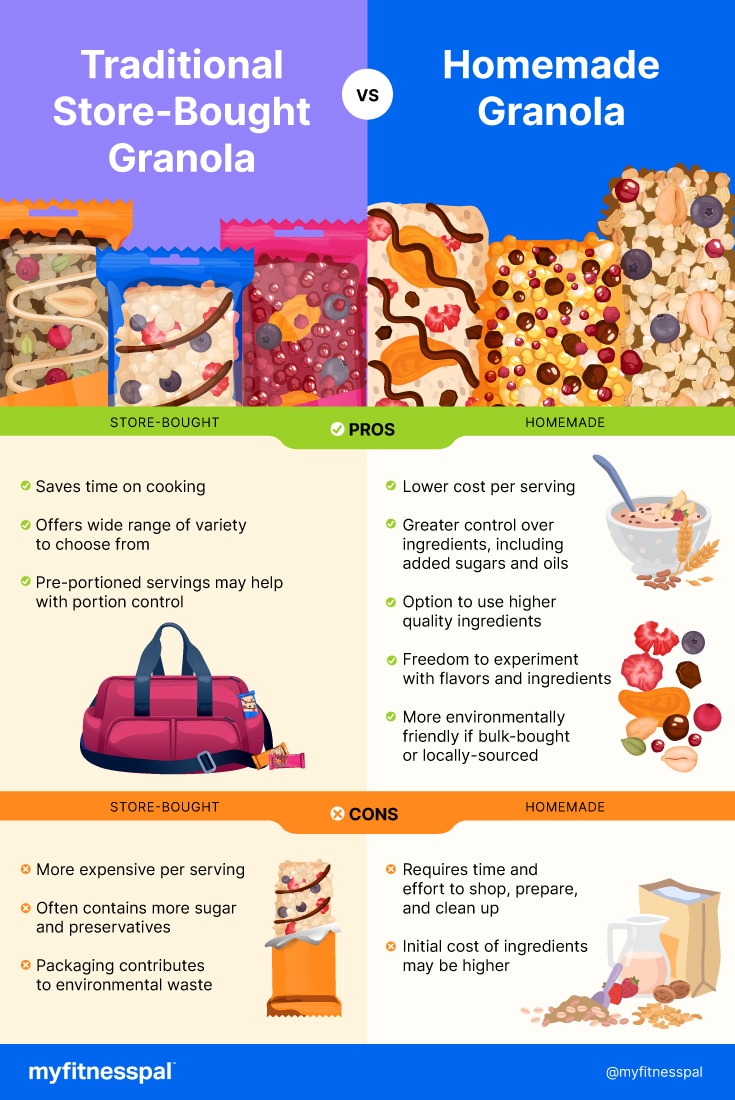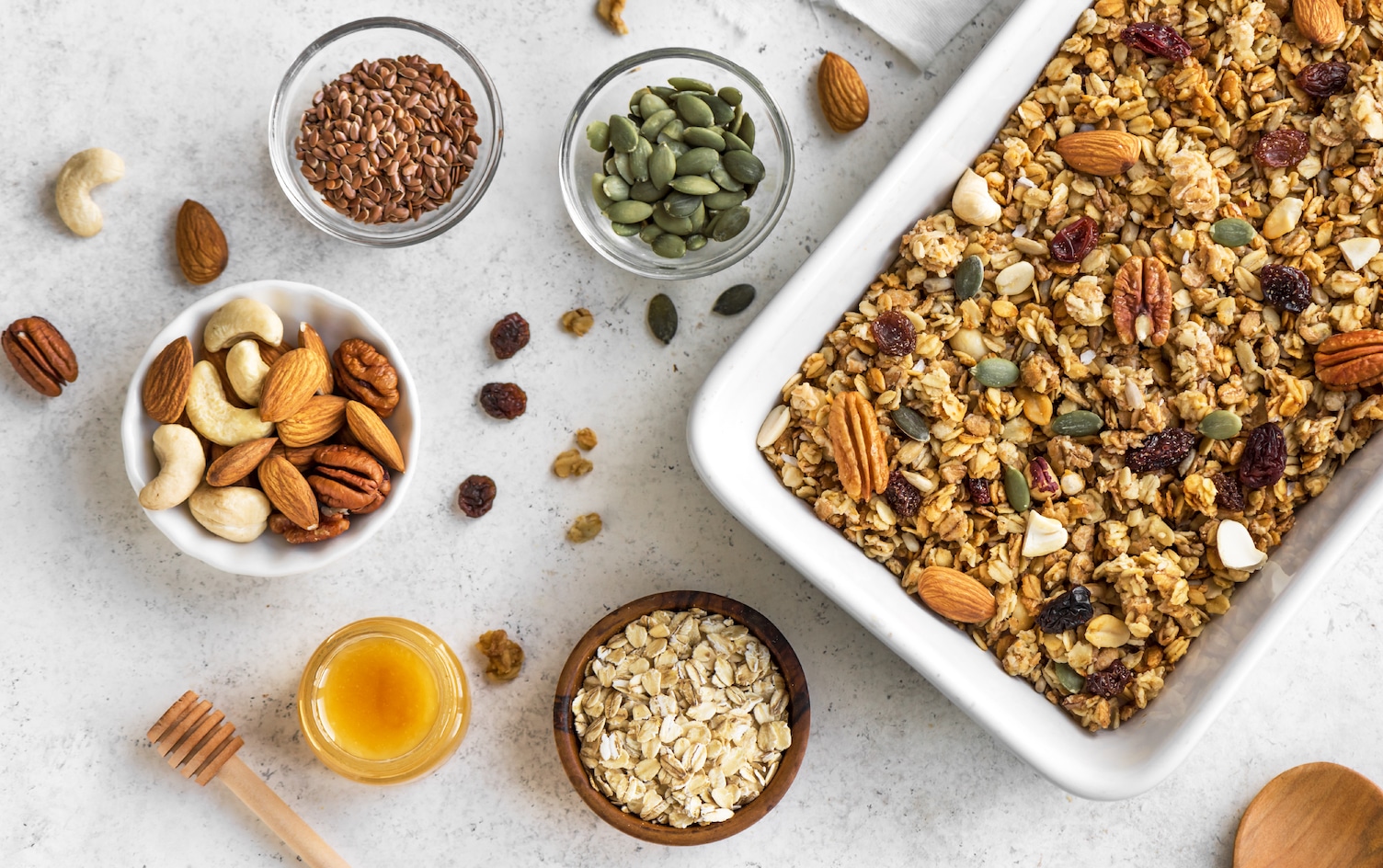Welcome to “Is It Worth It?”, a MyFitnessPal series that breaks down the pros and cons of store-bought versus homemade foods. The goal of the series is to give you the knowledge you need to make nutrition decisions that align with your lifestyle, budget, values, and health goals.
Today: granola, a dietary staple known for its nutritional value and convenience as a quick breakfast option or healthy snack. Come along as we explore cost, health benefits, time and effort, and environmental impacts to answer the question, is making it at home really worth it?
Cost Comparison
When it comes to comparing the cost of making your own granola versus buying it from the store, there are a few things to consider. At first glance, it might seem like buying all the ingredients for homemade granola is pricier. However, you can make multiple batches with those ingredients, which means the cost per serving decreases over time. On the other hand, store-bought granola tends to be more expensive due to fancy packaging, well-known brands, and convenience.
Let’s take a specific example to illustrate the serving size comparison between homemade and store-bought granola.
Imagine spending $15 on ingredients for homemade granola. This could give you around 15 servings, making the cost per serving about $1. Now, consider a bag of store-bought granola that costs $7 and provides about 7 servings. The cost per serving of store-bought granola is also $1.
But it’s worth noting that you’ll still have leftover ingredients after making your first batch of homemade granola. These remaining ingredients can be used to make another 15 servings at no additional cost, effectively reducing the cost per serving to $0.50. Once you finish a bag of store-bought granola, though, you’ll need to purchase a new one for the same price, keeping the cost per serving constant at $1.
Health Benefits
When it comes to granola, making it at home has some benefits that might beat settle the store-bought versus homemade debate for you. That’s because you have control over the ingredients. By making your own granola, you get to decide what goes into it.
So, while store-bought may seem convenient, making granola gives you the opportunity to make it so that it aligns with your taste preferences and nutrition goals.
- Less added sugar: Many store-bought granolas contain a lot of added sugars (think: white refined sugar, brown sugar syrup, tapioca syrup, high-fructose corn syrup), which can impact your health and weight loss goals if eaten in excess. By making your own granola, you have the power to sweeten it the way you like.
- More fiber: DIY granola also gives you the ability to amp up the fiber content by using oats, nuts, seeds, and dried fruit. Some store-bought granolas skimp on fiber-rich ingredients due to cost. Not only does a high-fiber diet help maintain a healthy weight, but it also keeps your digestive system happy and may lower the risk of heart diseases.
- More protein: When made at home, you can easily boost protein levels by adding ingredients like nuts, seeds, and almond butter. This is a great way to help your body repair cells and build new ones. Plus, adding more protein to your diet can help you build and maintain lean muscle mass, which is really helpful for losing weight. Store-bought granola might not always offer this level of protein.
- No preservatives or additives: Commercial brands often use preservatives and additives to extend the shelf life of their products. Homemade granola is free from these unwanted extras.
TRY > Nutty Six-Ingredient Granola
Time and Effort
Making granola at home requires time and effort. You’ll need to shop for ingredients, mix them, bake the granola, and then clean up afterward—which is undoubtedly more time-consuming than grabbing a bag off the shelf at the store. If you prioritize convenience or have hectic schedules, store-bought granola can be a more appealing option.
But, depending on your health and weight goals, the time might be worth it. A typical serving of commercial granola has about 200 calories, with at least 50 of those from processed sugars. If you’re spooning out 2-3 servings per week, that’s an added 400-600 calories each week—or 1600-2400 calories per month!
By using less added sugars, you can reduce the caloric value to around 150 per serving. That’s a saving of 50 calories per serving, or 100-150 calories per week, and 400-600 calories per month.
Environmental Impact
The environmental impact is another consideration in the homemade vs. store-bought debate. Pre-packaged granola often comes in single-use plastic which contributes to waste.
On the flip side, homemade granola, especially when made with locally-sourced or bulk-bought ingredients, drastically reduces the need for packaging and can be stored in reusable containers, making it a more eco-friendly choice.
Summary of Pros and Cons

Homemade Granola:
Pros
- Lower cost per serving when ingredients are used for multiple batches
- Better control over ingredients—make it healthier with less added sugar, more protein and fiber
- Option to use higher quality ingredients
- Freedom to experiment with flavors and ingredients
- More environmentally friendly if using locally-sourced or bulk-bought ingredients
Cons
- Requires time and effort to shop, prepare, and clean up
- Initial cost of ingredients may be higher
Store-Bought Granola:
Pros
- Convenient and time-saving, ideal for busy schedules
- Offers a wide variety of flavors and dietary options
- Pre-portioned servings provide ease of use
Cons
- Typically more expensive per serving due to packaging and branding costs
- Often contains higher sugar content and preservatives
- Packaging contributes to environmental waste
TRY: Coconut Quinoa Hazelnut Granola
Bottom Line
When contemplating whether to bake up a batch of granola in your own kitchen or to toss a store-bought version into your shopping cart, consider what matters most to you.
Are you looking to save money in the long run, or is the immediate convenience more appealing?
Do you want full control over the ingredients and flavor?
How much does your environmental footprint play a role in your final decision?
Ultimately, the decision lies on weighing these factors and choosing what aligns best with your lifestyle, values and health goals.




